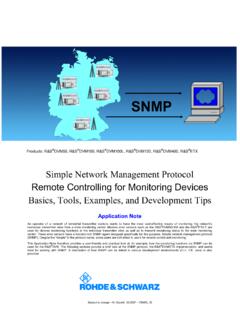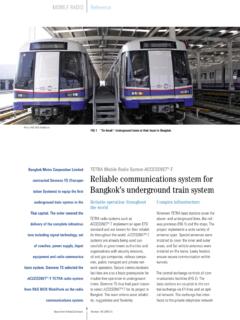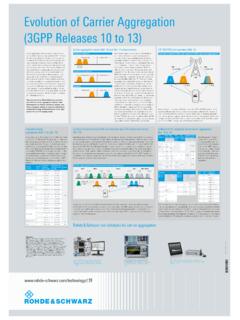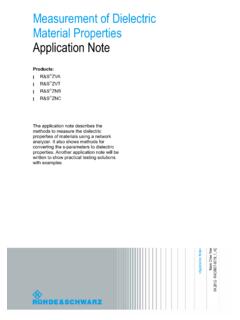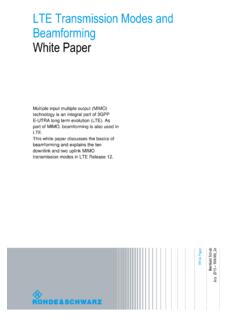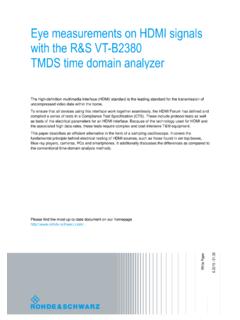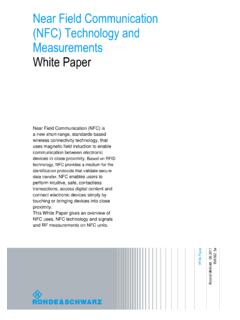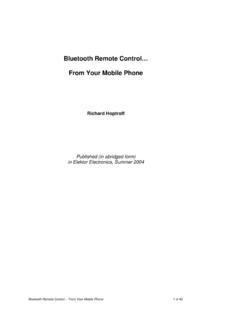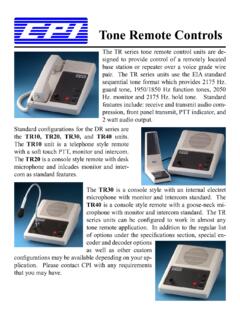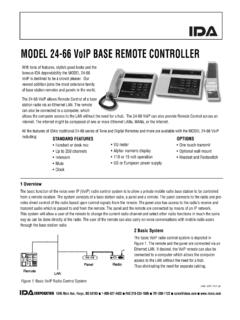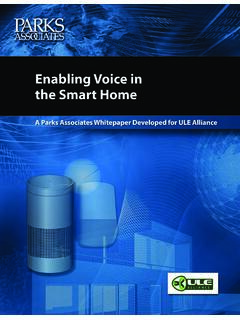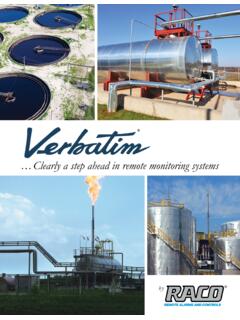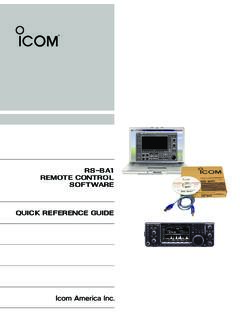Transcription of Europe’s air traffic control on the way to voice over IP
1 europe s air traffic control on the way to voice over IPNEWS Offprint from News 2012 europe s air traffic control on the way to voice over IPVoice communications systems will continue to be absolutely essential for the safe handling of air traffic in europe in the future. But the rapid technical development opens up completely new opportunities for air traffic control (ATC) organizations. They are subjecting these new methods to thorough tests, for high safety requirements must be met. This careful migration is made possible by the radios of the R&S Series4200 family, because they support several communications technologies that make migration and tested in changing timesAll flights based on instrument flight rules (IFR) require a con-stantly available voice connection between pilot and air traf-fic controller. For this reason, voice communications are one of the most important working bases in air traffic control . The technical basis for voice communications is a radio network that ensures countrywide coverage during all phases of the flight independent of altitude.
2 For this purpose, radio stations with radios and associated RF components, such as trans-mitter / receiver filters, couplers and antennas, are installed at suitable radio locations, e. g. at airports or on mountaintops. Depending on the operational requirements, a number of radio channels are available for each location, combined with the corresponding number of device installations. To ensure the availability of the radio system in case a component fails, additional devices are installed to provide radio systems as well as the air traffic controllers with their controller working positions (CWP) are connected with the terrestrial voice communications system (VCS). The VCS connects the controller working positions dynamically or semipermanently with the associated radio systems so that the air traffic controllers can work on the frequency assigned to their respective sectors. The assignment of a CWP to a radio channel can change depending on the time of day and the traffic volume.
3 From a technical and organizational per-spective, it is also possible that sectors are taken over by air traffic controllers who are working at other locations. The connection of the radio systems and controller working positions or the interconnection of individual voice switch-ing nodes is made using analog telephone lines or via digital transmission lines with 2 Mbit/s in line with the ITU-T standard. The transmission lines for connecting radio loca-tions are leased by the ATC organization from a telecommuni-cations provider. However, many providers in europe no lon-ger offer analog landlines, since they can hardly be operated economically anymore. In the near future, the digital trans-mission technologies that have been used for years, such as plesiochronous digital hierarchy (PDH) and synchronous dig-ital hierarchy (SDH), will also no longer be available for con-necting remote radio stations to the voice switching system.
4 Alternatives are in demand and also in sight: voice over IP (VoIP) is an obvious choice, due to its widespread use and the many years of experience with this technology in the classic telecommunications environment. VoIP is not only a replace-ment for analog or PDH transmission technology; it also offers several significant advantages. VoIP: communications technology of the future for air traffic controlVoIP systems no longer transmit voice over a circuit-switched voice network, but over an IP-based packet-switched data network. For this purpose, the voice signal is digitized at the source and divided into IP data packets. The data network consists of routers that handle the routing of the voice pack-ets and the data packets on the basis of the IP address. At the information sink, the digital voice packets are converted back into an analog savings through integrated voice and data networksATC organizations already operate extensive data networks, e.
5 G. for the transmission of radar and flight plan data. There-fore, it seems reasonable to transmit voice and data over a single network in the future, as is possible with VoIP. At remote locations, the integration of voice and data into a common network is particularly advantageous, for it also saves money only a single network must be planned, installed and networks that should also transmit digital voice infor-mation must meet special requirements, for this information must be transmitted in realtime and with absolute reliability. The radios are remote -monitored and remote -controlled via an IP-based data connection. In the future, voice transmission as well as remote monitoring will run via the same IP interface on the radio. Simple setup While the technical planning of the data networks as described above is more complex, the installation of the VoIP network components simpler. This is because standard cabling and components, which are already in use for today s LAN technology, are sufficient.
6 All security mechanisms known from the data world, such as Internet protocol secu-rity (IPSec), and prioritization techniques, such as differenti-ated services (DiffServ, RFC 2474, RFC 2475) or multiprotocol label switching (MPLS), can also be used for voice transmis-sion via of routing technology into the IP networkAnother advantage of VoIP systems is the possibility of doing without central switching nodes such as those required in circuit-switched voice networks. For security reasons, today s routing technology is designed redundantly in the voice net-work which results in added costs. In an IP-based data net-work, the data packets are not distributed by a central unit but by routers whose number and performance are deter-mined by the size and requirements of the network. The router decides, based on the IP address of the information sink, where the packet should go. Consequently, the infor-mation source only needs to know the IP address of the Series4200 software defined radiosThe Series4200 is the latest generation of digital software defined radios for stationary use in civil and military air traffic con-trol.
7 The possible applications range from small emergency radio systems with only a few channels to nationwide radiocommunica-tions systems with several hundred channels. VHF frequency range from 112 MHz to 156 MHz UHF frequency range from 225 MHz to 400 MHz 50 W transmit power in VHF and UHF range Automatic main/standby operation USB service interface for configuration and software downloads remote control and remote monitoring via Ethernet interface Suitable for data transmission in VDL mode 2 standard Connection via E1 interface voice over IP via software upgrade3 VoIP infrastructureRecordingRadio siteWANR adiointerfaceRadio/telephoneinterfaceRad io/telephoneinterfaceRadio/telephoneinte rfaceVCSN etwork supervisionVCSLANR outerCWPR ecordingVCS maintenanceconfigurationMedia gatewayPSTNATS-QSIGMFCR adio4communications partner. The addresses defined in an address plan that can dynamically be adjusted to the operational con-ditions.
8 Therefore, the data packets are switched via sev-eral routers distributed in the network, and not centrally. The advantage is that existing redundancy mechanisms in the IP network can be utilized. Implementation of new functionsSpeaking in favor of the introduction of VoIP is not only that it replaces transmission methods which are no longer available, but also that new functions can be implemented in the voice communications system functions that are difficult to imple-ment using today s circuit-switched example are the functional airspace blocks (FABs) planned within the framework of the Single European Sky initiative, in which several countries are united into one FAB, e. g. the FABEC (FAB europe Central), comprising France, Belgium, the Netherlands, Luxemburg, Switzerland and Germany. These FABs no longer organize the airspace over europe according to national borders, but with a view toward achieving the highest possible efficiency in utilizing the air-space so that air traffic can be handled in a more time- and cost-saving way.
9 One of the many requirements for an FAB is the harmoniza-tion of the communications technology to ensure sufficient FIG 1 VoIP infrastructure for use in air traffic control (source: EUROCAE ED136).Internet protocolsSignaling &controlNetwork &config. layersFTPHTTPS ession layerIP (IPv4 / IPv6)Network layerPSTN10 layerinteroperability. Today, every country has its own operational processes and different communications technology with which the air traffic controllers communicate with each other and with the pilots. Communications between air traffic con-trollers across borders run via telephone connections. Today, it is not easily possible for an air traffic controller in one coun-try to optionally access the radio infrastructure of another country. But this is necessary if FABs are to be introduced, since an air traffic controller from one country must be able to operate the sector that is covered by the radio infrastruc-ture of another country.
10 Only VoIP technology provides the prerequisites for such functions. Plus, this technology offers the means of introducing additional performance features that make communications between air traffic controllers and pilots easier and more order to make VoIP usable for ATC applications, the Euro-pean Organization for Civil Aviation Equipment (EUROCAE) created a working group the WG67. Based on the exist-ing requests for comments (RFCs), its task is to develop stan-dards that will enable the use of VoIP. These standards allow interconnection of radios, VCS and CWP from different man-ufacturers. The WG67 consists of representatives from ATC organizations (air navigation service providers, ANSP) and industry. The infrastructure to be standardized is specified in the Vienna Agreement (FIG 1). The necessary requirements and specifications are defined in several documents [1 to 7] which were ratified at the end of 2008 and have been official EUROCAE documents since February 2 Selection of protocols commonly used in the IP world, presented in line with the ISO/OSI 7-layer April 2008 and March 2009, the specifications were val-idated in plug tests.
